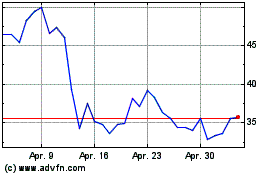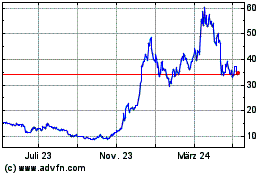Mangata Finance’s Polkadot-based Efficient, MEV-Free DEX Coming June 6th
12 Mai 2022 - 8:01PM
NEWSBTC
Mangata Finance, the Polkadot-based DEX, is all set for launch on
June 6th. Recently, it had a successful crowdloan that was closed
in just under an hour that secured it a slot on Polkadot’s
innovation network Kusama. Over $2 million in value was bonded
through the crowdloan, a process of staking Polkadot (DOT) tokens
to support a specific project in the Polkadot Slot Auction, in
return for which participants receive rewards from the projects.
The project also raised $4.2 million in equity, which came shortly
after the launch of its first blockchain on the Kusama network,
which raised the Polkadot startup’s valuation to $60 million. New
investors including Signum Capital, IVC, Figment, ZMT Capital,
AngelDAO, and Paribu Ventures joined the returning investors
Altonomy, Polychain, and TRGC in this strategic round. “Altonomy
believes in Mangata’s efforts around connecting major blockchains,
improving security for traders, and helping reduce fees by
eliminating gas from the equation, which is why we returned for a
second round of funding,” said Altonomy Director Ricky Li. Olaf
Carlson-Wee, the founder and CEO of investment firm Polychain
Capital, was actually the first one to fund Mangata’s vision of
efficient DEXes without MEV. Leveraging Polkadot Interoperability
The Slovakia-based Mangata is both a blockchain and DEX that will
be connected as a parachain in the Polkadot ecosystem. By choosing
Polkadot for its multi-purpose DEX, Mangata wants to leverage the
key value proposition of Polkadot, which is interoperability.
Polkadot is a layer 1 blockchain network designed to support
various interconnected, application-specific chains called
parachains. Each chain built within its network uses the Substrate
modular framework of Parity Technologies, allowing developers to
select specific components that suit their chain the best and
optimize their chains for specific use-cases This entire ecosystem
of parachains plugs into a single base platform called Relay Chain.
This base platform is responsible for providing security to the
network’s parachains and contains Polkadot’s consensus and voting
logic. Mangata is a one-stop-shop for easy and secure trading of
Polkadot (DOT) assets while serving as a bridge between Ethereum
and Polkadot so that assets can be seamlessly migrated on-demand
between the two ecosystems. It is actually the first parachain to
build a specialized ETH <> Polkadot trading UI. Besides
connecting these two significant blockchains, Magnata connects
other popular layer 1 blockchains; Cosmos, Solana, and Avalanche.
Novel Proof of Liquidity Mechanism Founded in 2020 by Peter Kris,
who previously founded European web3 studio Block Unison, and CTO
Gleb Urvanov, a computer scientist, Mangata aims to solve some of
the biggest problems in terms of insider trading and institutional
adoption that DeFi and the crypto market faces at large. Other
barriers to mainstream DEX adoption involve complex structure,
price oracle manipulation, and flash loan attacks. With a team of
14 people, which includes software engineers, product designers,
blockchain experts, and business strategists, Mangata believes it
is uniquely positioned to deliver on its goal of eliminating these
problems. To advance the adoption of DeFi and crypto, Mangata will
be using its funding to offer low fixed fees per operation, capital
efficiency via on-chain limit orders, and MEV prevention while
providing the first UI to trade ERC20 tokens with native Polkadot
assets. This community-driven DEX is secured through its unique
Proof of Liquidity mechanism, which reuses liquidity to ensure
chain security. This helps create deeper liquidity pools, increases
capital efficiency, and allows stakers to be rewarded twice.
“Mangata’s unique Proof-of-Liquidity mechanism raises the bar on
chain security and staking rewards, and our no-gas economy does
away with slow, expensive settlements rampant on other blockchains.
This latest round of funding will enable us to continue our mission
to create a better crypto market for everybody within the Polkadot
ecosystem and beyond,” said CEO Kris. Moreover, the project
deliberately does not support smart contracts, self-executing
contracts directly written into lines of code, to further shield
itself from exploitation by malicious actors or bots. The first
production-ready Layer-1 DEX blockchain also prevents dominant
forms of price manipulation and maximal extractable value (MEV).
While other blockchains are vulnerable to frontrunning bots,
Mangata DEX stops them on the consensus layer with a new block
production method, Themis architecture, which makes frontrunning
next to impossible. On top of all these benefits, Mangata’s design
eliminates gas from the swaps equation entirely, while other
blockchains like Ethereum charge extremely high gas fees, pricing
out small users. This allows for faster settlements at no
additional cost, as well as new strategies like dollar-cost
averaging. Algorithmic buy & Burn The way the DEX is designed
ensures fixed fees while providing greater control over trading
costs and increased opportunities for arbitrage. Besides addressing
the limitations of DeFi, Mangata has also implemented a novel
algorithmic buy and burn mechanism that will reflect the protocol’s
success in the price of its native token MGX. The way this
mechanism works is 0.05% of the 0.3% commission charged by Mangata
X will be used for this algorithmic buy and burn. Meanwhile, 0.2%
will go to liquidity providers as LP fees and 0.05% to the
Treasury. MGX is hard-capped at 4 billion, and right at the launch,
1 billion MGX will be released to allow for deep liquidity. Eighty
percent of MGX tokens’ supply will actually be distributed to the
community, out of which 30% is set aside for validation rewards,
and 37.5% is for LP rewards. Now, ahead of its launch, Mangata is
partnering with other DeFi protocols like Acala, Oak Network,
Bifrost and Moonriver as it moves forward to make the cross-chain
future happen and allow tokens to flow freely from one blockchain
to the other. All in all, Magnata aims to create a high-quality
trading system that facilitates community access to early-stage
Polkadot projects.
Avalanche (COIN:AVAXUSD)
Historical Stock Chart
Von Mär 2024 bis Apr 2024

Avalanche (COIN:AVAXUSD)
Historical Stock Chart
Von Apr 2023 bis Apr 2024
